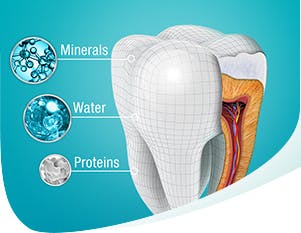Enamel Hypoplasia: Causes and Treatment
Your tooth enamel, which is the white outer surface that covers your teeth, is the hardest substance in your entire body.1 Enamel is 96 percent mineral, making it stronger than bones and resistant to damage.1 Although enamel plays an important role in ensuring that your teeth are strong, people with enamel hypoplasia may not have the same level of protection. Enamel hypoplasia is a condition that affects the production of enamel.
What is enamel hypoplasia and how does it form? Read on to learn more about this condition and what you can do to treat it.
What Is Enamel Hypoplasia?
Enamel hypoplasia is a defect that can occur when there’s a disruption during enamel formation. There are three types of enamel defects: hypoplasia, hypomaturation, and hypomineralization.2 Enamel hypoplasia is a surface defect of the tooth crown that is caused by the disruption of enamel formation.3 This means that if the formation of your enamel is affected, it is unable to fully form and protect your teeth. Hypomineralization occurs when there are problems with the mineral levels in the tooth.2
What Does Enamel Hypoplasia Look Like?
Enamel hypoplasia may appear as pits or grooves on the surface of your teeth.3 Brownish, yellow, opaque or white discoloration or defects on the surface of the teeth can also be signs of enamel hypoplasia.3 In some cases, enamel hypoplasia can be the total absence of enamel on your teeth.3
Is Enamel Hypoplasia Common?
Enamel defects like enamel hypoplasia are common in the general population.4 In fact, an estimated range of 20 to 80 percent of people in the world have an enamel defect.4 Some people with enamel defects may only experience side effects on some of their teeth.4 Although enamel hypoplasia can happen in any permanent tooth, the teeth that are most likely to be affected are the permanent first molars, canines, and the incisors with specific areas of defect.2,3
How Does Enamel Form?
Enamel is formed by a mixed population of cells.4 Among this population are ameloblasts, which are the cells that are primarily responsible for the formation and mineralization of enamel.4 The life cycle of ameloblasts are divided into six stages, which are morphogenetic, organizing, formative, maturative, protective and desmolytic.3 The process of enamel formation is called amelogenesis, which occurs during the formative and maturative stages of the ameloblasts’ life cycles.3
What Causes Enamel Hypoplasia?
Enamel defects such as enamel hypoplasia can be caused by both hereditary and environmental factors.3 Hereditary enamel hypoplasia, or amelogenesis imperfecta is passed down through families and can affect all of the enamel on your teeth.3 Environmental factors of enamel hypoplasia include certain illnesses (such as chicken pox and measles), malnutrition, premature births or trauma and infection of a tooth.3 Deficiencies in vitamins A, C and D and minerals such as phosphorus and calcium can result in enamel hypoplasia.2 Exposure to tetracycline and lead during the dental development stage can also lead to enamel hypoplasia.5
Dental fluorosis, or the condition that occurs to young children aged eight and younger who ingest too much fluoride is another likely cause of enamel hypoplasia.2 Although fluoride is a mineral that is beneficial to strengthening the enamel, fluoride ingestion can cause enamel hypoplasia as well.3 If you are a parent to a young child, be sure to avoid having your child ingest fluoride when they brush their teeth.2
Can Enamel Hypoplasia be Treated?
Enamel hypoplasia can be treated with a tooth colored composite resin, veneers, or a crown.6 Resin treatments work to improve the appearance of teeth that are affected by enamel hypoplasia and help improve the function of the teeth.6 The process of applying resin is simple, but should only be done by a dental professional.6 Talk to your dentist to find out more about treatment options for your teeth.
Why Is Caring for Your Enamel Important?
Although Pronamel doesn’t treat enamel hypoplasia, protecting your enamel is important because healthy enamel keeps teeth free from cavities and other oral health issues. Although your enamel is strong, it can’t repair itself like the other tissues in our bodies.1 Once the enamel is damaged, your teeth can only be restored by a dentist.1 In order to keep your enamel strong and healthy, brush twice a day with a fluoridated toothpaste like Pronamel Intensive Repair Clean Mint toothpaste. This advanced* enamel care formulation helps to remineralize the enamel on your teeth, leaving it stronger and more protective. You can also try Pronamel Gentle Whitening toothpaste to help remove stains and restore teeth to their natural whiteness.
When it comes to treating enamel hypoplasia, your dentist knows the best solution to help restore the appearance and functionality of your teeth. Find more tips on enamel care and healthy living with Pronamel.
*Within the Pronamel range.
Source Citations:
- 5 Reasons Your Smile Is Stronger Than You Think. American Dental Association. https://www.mouthhealthy.org/en/fun-teeth-facts-part-2 Accessed 6/30/2022.
- Amelogenesis Imperfecta: An Introduction. British Dental Journal. Accessed 9/13/22. https://www.nature.com/articles/sj.bdj.2012.314
- Enamel hypoplasia and its role in identification of individuals: A review of literature. National Library of Medicine. https://www.ncbi.nlm.nih.gov/pmc/articles/PMC4455163/ Accessed 6/30/2022.
- Dental Enamel Formation and Implications for Oral Health and Disease. National Library of Medicine. https://www.ncbi.nlm.nih.gov/pmc/articles/PMC6151498/ Accessed 7/6/2022.
- Enamel hypoplasia in the primary dentition: a review. National Library of Medicine. https://pubmed.ncbi.nlm.nih.gov/1783694/ Accessed 7/6/2022.
- Aesthetic approach for anterior teeth with enamel hypoplasia. National Library of Medicine. https://www.ncbi.nlm.nih.gov/pmc/articles/PMC3354799/ Accessed 7/6/2022.




